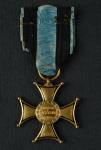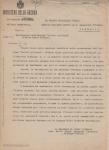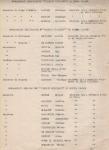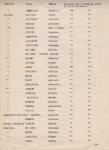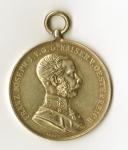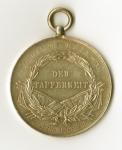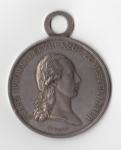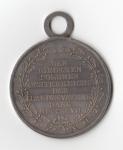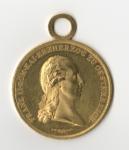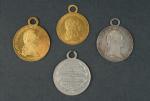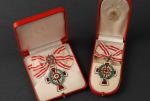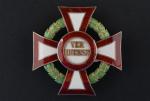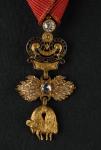-
Posts
1,161 -
Joined
-
Last visited
-
Days Won
17
Content Type
Profiles
Forums
Blogs
Gallery
Events
Store
Everything posted by Elmar Lang
-
A very fine specimen indeed, although I'm not sure whether the piece would have been made by Rothe or not. The ribbon, besides the Kleindekoration,, looks like a pre-1918 one! E.L.
-
Hello, a branch of my collection is devoted to the Polish Military Order "Virtuti Militari". Among the pieces I've been lucky enough to find, one is -in my opinion- very interesting: the "Gold Cross" or IV Class awarded to Lt. Casimiro Buttini. (Born in Saluzzo, Piedmont, on Oct. 29th 1887, died in Saluzzo, on Febr. 23rd, 1959). He reached the rank of Colonel in the newborn "Regia Aeronautica" (Royal Military Air Force). He was a bomber pilot, flying on the famous "Caproni" machines, one of the best "heavy bomber" airplanes of its time. This officer, during WW1 was decorated with a Silver and a Gold Medal for Military Valour. The latter, for an action on Tarnova, in 1917 where, while bombing the Austrian lines, his airplane was target of intense fire from the enemy and a shell lirerally beheaded his 2nd pilot. Buttini, although wounded to the head and an arm, calmly kept the airplane in flight, continuing the bombing. The plane was severely damaged by the enemy fire, but the pilot kept the machine in flight, and the crew in order. When the plane, due to the damages started to fall, he succeeded to avoid crashing on the enemy position, until a safe landing behind the Italian lines. After the war, some Italians received a proper class of the "Virtuti Militari", from the new Polish Republic. A necessary condition to receive the Polish Order, was to be already decorated with the Gold Medal for Military Valour or at least 4 Silver Medals for Military Valour. I have a list, compiled by the Office of the Chief of the General Staff at the Ministry of War, addressed to Colonel Ivaldi, Italy's military attaché to the Royal Italian Legation in Warsaw with the names of the men, worth of the award of the Virtuti Militari. In this list, Casimiro Buttini results as having been proposed for the V Class (the Silver Cross), but the Polish Authorities, actually awarded the higher IV Class, as recorded in the official list of the Order. The cross was found at antique fair in Parma, back in 1993. The whereabouts of Buttini's other medals and decorations are to me unknown. Following, the pictures of the obverse and reverse of the cross, struck with the number "528" and of the letter with attached list from Italy's General Staff Office. Best wishes, Enzo (E.L.)
-

Italy Italy - British Crimean medal to Sardinian Troups
Elmar Lang replied to Veteran's topic in Southern European & Balkan States
Corporal Pietro Laugero, received a Bronze "Al Valore Militare" medal for an action in Sop (Serbian Macedonia), on Sept. 29th, 1918. He remained the only survivor of his machine-gun section and continued to fire his weapon, facing the overwhelming enemy, keeping his position, although the order to retreat was given. Only when the retreat was completed, he went back to the new position, not abandoning his arms, and carrying them in safe. Actually, a brave soldier indeed. E.L. -

Austria-Hungary WARNING - MMTO with diamonds on Ebay
Elmar Lang replied to Xtender's topic in Austro-Hungarian Empire
A few years ago a Grand Cross badge of this same order (and manufacture), mounted on a sash of the Order of the Crown of Italy, appeared on eBay; then sold before the "auction"'s end. By the way, it's typical, on eBay, to read remarks like "I'm not an expert, etc.etc.", after an apparently so-so scientifical or überdetaillierte description... Best wishes, E.L. -

Italy Italy - British Crimean medal to Sardinian Troups
Elmar Lang replied to Veteran's topic in Southern European & Balkan States
Very interesting indeed: this is the italian award document for the British Crimea medal. Best wishes, E.L. -

Austria-Hungary Order of the Iron Crown
Elmar Lang replied to Carol I's topic in Austro-Hungarian Empire
Hello, the badges of early manufacture (like those pictured above), were made of solid gold. Later ones, let's say from 1880/90 onwards, were usually hollow. Best wishes, E.L. -
The Silver Red Cross Medal without Kriegsdekoration is a rare piece indeed. The medal in this discussion is a Kriegsmetall-made piece with enamelled centre medallion. In order to ascertain whether the piece was originally a silver or bronze one, it needs to thoroughly examine the ring to see if any trace of silver plating would have remained or not. To the right of "AC" in the motto, I see some brown-reddish colour, that could be either a trace of the original bronze finish, or just an effect in the picture. I can say too, that the Red Cross medals made in Kriegsmetall, are always less common than their "precious" counterparts. Best wishes, Enzo (E.L.)
-

Austria-Hungary Sweet little miniature
Elmar Lang replied to Peter J's topic in Austro-Hungarian Empire
I'm not much into miniatures, but sometimes I can't miss to acquire certain pieces... E.L. -

Austria-Hungary An engraved, WW1 Tapferkeitsmedaille
Elmar Lang replied to Elmar Lang's topic in Austro-Hungarian Empire
Dear Glenn, your reply arrived while I was typing my post. Yes, a perhaps is necessary, since the engraving on my medal refers to the 1914-1916 campaign. Farkas's Goldene Tapferkeitsmedaille was awarded in Oct. 1917, when the type of medal should have been with Emperor Karl's portrait. If my medal actually belonged to Farkas, it could have been gilt after the war, for unknown reasons and having been his Silberne Tapferkeitsmedaille 1.Klasse. Or one of the Silberne Tapferkeitsmedaillen 1. Klasse awarded until the early 1917 to a junior officer of the JR 33. All the best, Enzo -

Austria-Hungary An engraved, WW1 Tapferkeitsmedaille
Elmar Lang replied to Elmar Lang's topic in Austro-Hungarian Empire
Hello again, a more patient research in the 1918 Rang-Liste, helped me to see that all the 10 officers were still on duty in the JR 33. Géza Olajos was then Leutnant (and not anymore in der Reserve); Johann Léger and Karl Kurtag appear as promoted to Oberleutnants. One name: Josef Farkas, Leutnant der Reserve, appears as having been decorated with the Goldene Tapferkeitsmedaille along with the MVK III Kl. KD u. Schw.; the Bronzenes "Signum Laudis" am Kriegsband m. Schw.; the Silberne Tapferkeitsmedaille 1. Klasse; the Silberne Tapferkeitsmedaille 2. Klasse and the Karl Truppenkreuz. There's a chance that the gilding could be old and the medal could have been a present to that brave, young officer. With my gratitude for the precious help, Enzo -

Austria-Hungary An engraved, WW1 Tapferkeitsmedaille
Elmar Lang replied to Elmar Lang's topic in Austro-Hungarian Empire
That's excellent; a warm thank you to both Ian and Glenn, replying to my enquiry. I will look through the 1918 Rang-Liste and see whether any of the mentioned officers were still attached to the JR 33. Curious, is the fact of the medal's gilding, but this could have happened anytime after WW1... Best wishes, Enzo -

Austria-Hungary An engraved, WW1 Tapferkeitsmedaille
Elmar Lang replied to Elmar Lang's topic in Austro-Hungarian Empire
That's very interesting, thank you! I think I should try to put together a complete series of the k.u.k. Schematisma and Rang-Listen from 1914 to the end of the war: they are more important than a single, fine decoration. Enzo -

Austria-Hungary An engraved, WW1 Tapferkeitsmedaille
Elmar Lang posted a topic in Austro-Hungarian Empire
Hello, Yesterday, I've visited an old friend of mine in Cortina d'Ampezzo. He showed to me some pieces and discussed about some of them. Later, I've been able to acquire from him a Tapferkeitsmedaille: its an usual 1st Class medal in silver type 1914-1916 (struck with the "A" mark on the rim): curiously it has an old, partially worn gilding and its reverse is engraved "OFFIZIERSKORPS DES J.B. IV/33" on top and below, "FELDZUG 1914-1916". The engraving is very well made, I need to say. It is complete with a fine, original ribbon (removed by me, to better allow the scans). The text allows me to think that it refers to a present from the Officers of the 4th Battalion of the Infantry Regiment nr. 33 "Kaiser Leopold". Searching through the Rang-Liste of 1918 (I haven't earlier ones from WW1) I haven't found any junior officer from the mentioned regiment, with either the Goldene or the Silberne 1. Klasse Medal. Any further info, would most appreciated, Enzo (E.L.) -
The 1797 medal for Lower Austria (Niederösterreich), come in three grades: 1) Gold 2) Large Silver (same die as the Gold one) 3) Silver for troop, NCOs and junior officers (same die and size of the Silver Tyrol Medal 1797, but different inscription to the reverse (DEN BIEDEREN SOEHNEN OESTERREICHS DES LANDESVATERS DANK MDCCXCVII). I will provide pictures of these medals soon too. Best wishes, E.L.
-
Let's consider an officer's cross with pin like this one, as slightly rarer than the "usual" type with the two hooks and engraved dates. Here a few pieces from my collection; the "Verdienststern" with Kriegsdekoration (made by Souval); two 1st Classes, one of them for Ladies; an Officer's Cross with KD and a 2nd Class, also with KD. E.L.
-

Austria-Hungary Help with Tapferkeitsmedaille ribbon
Elmar Lang replied to lew's topic in Austro-Hungarian Empire
The Tapferkeitsmedaille has its own ribbon only, that is white with two red stripes; within them, alternated, very thin white and red horizontal stripes. The St. Stephen's ribbon visible in the pictures, looks like a modern one though... E.L. -

Austria-Hungary Military Merit Cross
Elmar Lang replied to Carol I's topic in Austro-Hungarian Empire
-

Austria-Hungary Order of the Golden Fleece
Elmar Lang replied to Carol I's topic in Austro-Hungarian Empire
Klein aber fein, a miniature of the Order of the Golden Fleece (already discussed in another section of this Forum):



